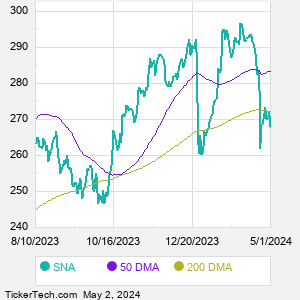Snap-on is a manufacturer and marketer of tools, equipment, diagnostics, repair information and systems solutions for users performing tasks including those working in vehicle repair, aerospace, the military, natural resources, and manufacturing. Co.'s reportable business segments are: Commercial and Industrial Group, which consists of business operations serving a range of industrial and commercial customers worldwide; Snap-on Tools Group, which consists of business operations primarily serving vehicle service and repair technicians; Repair Systems and Information Group, which consists of business operations serving other vehicle repair customers worldwide; and Financial Services.
When researching a stock like Snap-On, many investors are the most familiar with Fundamental Analysis — looking at a company's balance sheet, earnings, revenues, and what's happening in that company's underlying business. Investors who use Fundamental Analysis to identify good stocks to buy or sell can also benefit from SNA Technical Analysis to help find a good entry or exit point. Technical Analysis is blind to the fundamentals and looks only at the trading data for SNA stock — the real life supply and demand for the stock over time — and examines that data in different ways. One of these ways is called the Relative Strength Index, or RSI. This popular indicator, originally developed in the 1970's by J. Welles Wilder, looks at a 14-day moving average of a stock's gains on its up days, versus its losses on its down days. The resulting SNA RSI is a value that measures momentum, oscillating between "oversold" and "overbought" on a scale of zero to 100. A reading below 30 is viewed to be oversold, which a bullish investor could look to as a sign that the selling is in the process of exhausting itself, and look for entry point opportunities. A reading above 70 is viewed to be overbought, which could indicate that a rally in progress is starting to get crowded with buyers. If the rally has been a long one, that could be a sign that a pullback is overdue. |



